
Please click on the evolution of the Patriots uniform poster above for a close-up version of the poster. The descriptions below give you some insight and background about the uniforms and/or eras depicted in the poster.
Fall 2022: To purchase a reasonably priced 8" x 24" plaqued mounted version of the Patriots poster that's ready to hang on your wall, please visit Heritage Sports Stuff.
-------------------------------------------------------------------------------------------------
1960
Billy Sullivan Jr., a Boston businessman with a strong sports background, secured an AFL franchise on November 22, 1959. In keeping with New England history, the nickname Patriots was selected by a panel of Boston sportswriters because of the area’s heritage as the birthplace of the American Revolution.
The Boston team was involved in two significant "firsts" in 1960. On July 30, the Patriots defeated the Buffalo Bills in the first AFL pre-season game. Then, on September 9, they lost to the Denver Broncos, 13-10, in the first-ever AFL regular-season game.
The AFL began in 1960 as an 8 team rival league to the NFL. Both leagues competed head to head for players, fans and broadcast revenue. This was the way it was from 1960 to 1965 - two separate leagues, and two separate champions (although few people would have honestly believed that the AFL champion could have beaten the NFL champs).
Then in 1965 the two leagues agreed to merge. It was decided that beginning in 1970 there would be only one league, the NFL. In the interim, between 1966 and 1969, the AFL Champion would play the NFL Champion for the “World Championship”. It was only after the first World Championship had been played in 1966 that the name “Super Bowl” came into being.
The New England Patriots began life as the Boston Patriots when the AFL began in 1960. Joining the AFL as charter members were the Dallas Texans (now Kansas City Chiefs); Denver Broncos; Los Angeles Chargers (now San Diego Chargers); Houston Oilers (now Tennessee Titans); New York Titans (now New York Jets); Buffalo Bills and the Oakland Raiders.
During the Patriots' first decade, finding a suitable playing home in the Boston area was almost as urgent as putting a competitive team on the field. The Patriots played at Boston University Field in 1960 and 1961 and at Harvard in 1962 and again in 1970. From 1963 to 1969, the Patriots played at Fenway Park, home to baseball's Red Sox. In 1971, the team changed its name from the Boston Patriots to the New England Patriots and finally found a permanent home in Foxboro, Mass.
In spite of their stadium problems, the Patriots were frequent contenders during their AFL days. Mike Holovak, who replaced Lou Saban midway into the 1961 season, is the winningest coach in team history, with a 53-47-9 record. His best season was 1963, when the Patriots defeated Buffalo, 26-8, in a one-game playoff for the AFL East crown. New England lost the championship game to San Diego, 51-10.
This red home jersey has white numbers on the front and on both shoulders and sleeves, and the sleeves have blue and white stripes on the shoulders. The helmet is white with red and blue stripes, and includes the players number and a “Tri-cornered” hat.
-------------------------------------------------------------------------------------------------
1964
During the Patriots' first decade, finding a suitable playing home in the Boston area was almost as urgent as putting a competitive team on the field. The Patriots played at Boston University Field in 1960 and 1961 and at Harvard in 1962 and again in 1970. From 1963 to 1969, the Patriots played at Fenway Park, home to baseball's Red Sox. In 1971, the team changed its name from the Boston Patriots to the New England Patriots and finally found a permanent home in Foxboro, Mass.
In 1964 the Patriots finished with a 10-3-1 record, 2nd best in the league. Unfortunately, they were in the same Eastern Division as the 12-2 Bills, and thus the Pats did not advance to the championship game.
The team was lead by QB Babe Parilli who passed for a rather remarkable 3,465 yards and 31 td’s.
This red jersey sees the numbers shifted from the shoulders to the sleeves, and added blue and white stripes around the arms. Note the logo on the helmet has changed to a minuteman hiking the ball.
-------------------------------------------------------------------------------------------------
1969
The period of time between 1966 and 1969 warrants a bit of explanation. The 8 team AFL began in 1960 as a rival league to the NFL - both leagues competed head to head for players, fans and TV revenue. And thus it was for 5 years - two separate leagues, two separate champions (although few people would have honestly believed that the AFL champion could have beaten the NFL champs). Then in 1965 the two leagues agreed to merge. It was decided that beginning in 1970 there would be only one league, the NFL, and that between 1966 and 1969 the AFL Champion would play the NFL Champion for the “World Championship”. It was only after the first World Championship had been played in 1966 that the name “Super Bowl” came into being.
Thus the 1966 season saw the first meeting of the AFL and NFL champions, with the NFL Champion Green Bay Packers humbling the AFL’s KC Chiefs 33-10. (Even though the game was played in 1967, most football historians refer to this as the 1966 Super Bowl because it was the culmination of the 1966 season.) The NFL superiority was on display again in 1967, when the NFL’s Packers pounded the AFL’s Raiders 33-14.
Then came 1968 and the stunning upset - the AFL’s NY Jets shocked the football world by beating the NFL’s heavily favored Baltimore Colts 16-7.
Thus the stage was set for the Super Bowl IV, the last meeting between the AFL and NFL Champions.
During the Patriots' first decade, finding a suitable playing home in the Boston area was almost as urgent as putting a competitive team on the field. The Patriots played at Boston University Field in 1960 and 1961 and at Harvard in 1962 and again in 1970. From 1963 to 1969, the Patriots played at Fenway Park, home to baseball's Red Sox. In 1971, the team changed its name from the Boston Patriots to the New England Patriots and finally found a permanent home in Foxboro, Mass.
The Patriots finished this season with a losing record of 4-10.
Note the sleeves on this jersey. They are now shorter, with blue and red stripes along the edge. Note the change of the mask on the helmet. Also of note, the player uniform number is now on the back of the helmet, along with the logo of a minuteman hiking the ball.
-------------------------------------------------------------------------------------------------
1971
During the Patriots' first decade, finding a suitable playing home in the Boston area was almost as urgent as putting a competitive team on the field. The Patriots played at Boston University Field in 1960 and 1961 and at Harvard in 1962 and again in 1970. From 1963 to 1969, the Patriots played at Fenway Park, home to baseball's Red Sox. In 1971, the team changed its name from the Boston Patriots to the New England Patriots and finally found a permanent home in Foxboro, Mass.
The Patriots finished this season in third place with a 6-8 record.
This red jersey has added stripes along the neckline, and changed the stripes on the arms. The helmet logo remains that of the minuteman hiking the ball. Note that the player number has been removed from the back of the helmet.
-------------------------------------------------------------------------------------------------
1976
After the AFL-NFL merger in 1970, the Patriots suffered through a string of losing seasons. But in the late 1970's, they became serious contenders once again. The 1976 Patriots finished 11-3 and lost a close game in the first round of the playoffs to the eventual Super Bowl champion Oakland Raiders by score of 24 - 21. They won the AFC Eastern championship in 1978 and finished a close second in 1979.
QB Steve Grogan passed for 1903 yards and 18 td’s.
This white jersey has red numbers on the front and sleeves which are outlined in blue. The stripes on the arms are now larger, and the stripes along the neckline have been removed.
-------------------------------------------------------------------------------------------------
1978
After the AFL-NFL merger in 1970, the Patriots suffered through a string of losing seasons. But in the late 1970's, they became serious contenders once again.
The 1976 Patriots finished 11-3 and lost a close game in the first round of the playoffs to the eventual Super Bowl champion Oakland Raiders. They won the AFC Eastern Championship in 1978 and finished a close second in 1979.
QB Steve Grogan led the Patriots once again, passing for 2824 yards and 15 td’s.
This white jersey features red numbers on the front and sleeves, both of which are outlined in blue. The blue in the sleeve is more turquoise than it was previously.
-------------------------------------------------------------------------------------------------
1984
This season had Raymond Berry take over as coach and lead the Patriots to a 51-41-0 record over the next five and a half years. Berry took over from coach Ron Meyer, who in 2 seasons had an 18-15 record.
This season sees the Patriots finish second with a 9-7 record. However, they didn’t make the playoffs.
In the 1983 draft, the Patriots had the opportunity to draft QB Dan Marino. Instead, they passed him over for QB Tony Eason. This proved worthy as Eason led the Patriots with 3228 yards and 23 td’s in only his second year with the team.
This red home jersey has white numbering on the front and sleeves which are outlined in blue. The stripes on the arms have moved, and now run around the shoulders. The patch you see on the left shoulder of the jersey celebrates the AFL’s silver anniversary from 1960 to 1984.
-------------------------------------------------------------------------------------------------
1985
This season would see Coach Raymond Berry’s team finish with an 11-5 record, earning them a wild-card playoff berth. New England won three playoff games on the road and advanced to the Super Bowl for the first time in team history.
In Super Bowl XX, New England lost to the Chicago Bears 46-10 at the Louisiana Superdome in New Orleans in front of 73,818 fans. The game marked the end of G John Hannah's career. In 1991, Hannah would become the first Patriot to be elected to the Hall of Fame.
Although they lost in Super Bowl XX, the following year would prove interesting as they finish with an 11-5 record, finding themselves playing Denver in the AFC Divisional Playoff game. Played in Denver at Mile High Stadium before 76,105 fans, the Patriots couldn’t hold on for a win, losing 22-17.
This red home jersey is largely the same as the 1984 jersey, excluding the patch on the left shoulder.
-------------------------------------------------------------------------------------------------
1988
Under the new ownership of Victor K. Kiam II, the Patriots finish third in the AFC Eastern Division with a record of 9-7.
Playing for the Patriots for three seasons, QB Doug Flutie led the team once – in 1988 – in passing for 1150 yards and 8 td’s.
FB John Stevens had a great year rushing for 1168 yards and 4 td’s.
This white road jersey has red numbers on the arms and front, which are outlined in blue. The stripes around the shoulders have slightly changed, with the red, white, and blue stripes.
-------------------------------------------------------------------------------------------------
1993
In recent years, New England ownership has changed often, from Billy Sullivan to Victor K. Kiam II in 1988, and then to James B. Orthwein in 1992. The Patriots begin to feel the change under new ownership, and finish the season with a 5-11 record.
G John Hannah was inducted into the Football Hall of Fame in 1991. He played his entire career with the Patriots from 1973 through to the Super Bowl season of 1985. Regarded by many as the greatest guard to ever play the game, he was the first Patriot player to be inducted.
One of two Patriots voted to the NFL’s 75th anniversary team, he played in 183 games, which ranks fourth in franchise history. He only missed five games due to injuries during his 13-year career. He was also selected to nine Pro Bowls (1976, 1978 - 85); a Patriots team record. Called “The Greatest Offensive Lineman of All Time” by Sports Illustrated in their Aug. 3, 1981 cover story, he had been elected by his peers as the Offensive Lineman of the Year for four straight seasons (1978 - 81).
He powered an offensive line which helped set an NFL record with 3,165 rushing yards in 1978 – a record which has not been challenged in 17 seasons. Hannah was the first rookie offensive lineman in franchise history to start in his NFL debut. The Alabama product played for the legendary Coach Paul “Bear” Bryant and was drafted fourth overall by the Patriots in the 1973 NFL draft.
If you look closely at this jersey, you will note a smaller patch of the NFL shield on the jersey’s neckline. Most NFL uniforms added the NFL logo patch to the neck and upper left thigh of the pants beginning in 1991 - an exception being in 1994 when teams occasionally wore "throwback" uniforms celebrating the NFL's 75th anniversary.
This blue jersey is part of the dawn of a brand new uniform. The numbers move from the arms to the shoulders, making room for the new "flying Elvis" logo, which also appears on the side of the silver helmet. The pants are also changed, starting with a blue stripe which leads into smaller vertical stripes of red and blue.
-------------------------------------------------------------------------------------------------
1994
In recent years, New England ownership has changed often, from Billy Sullivan to Victor K. Kiam II in 1988, to James B. Orthwein in 1992 and finally to Robert Kraft in 1994. The team doesn’t let this change affect them as they work their way to a 10-6 record.
In 1994 the NFL celebrated its 75th anniversary (1920 - 1994). As part of the 75th anniversary celebrations, during selected games during the 1994 season, teams wore uniforms and helmets designed to resemble those from an earlier season in the team's history. The 75th anniversary was also commemorated by the diamond patch on the upper left part of the torso - this patch was worn on all 1994 jerseys whether they were "throwback" jerseys or not. While some teams wore the "throwback" uniforms for only a few games, others used them for most of the season - for instance the San Francisco 49ers wore them for almost the entire season, including the Super Bowl.
If you look closely at this jersey, you will note a smaller patch the NFL shield on the jersey’s neckline. Most NFL uniforms added the NFL logo patch to the neck and upper left thigh of the pants beginning in 1991 - an exception being in 1994 when teams occasionally wore their "throwback" uniforms.
In 1994 most NFL teams celebrated their history by occasionally wearing "throwback" uniforms celebrating the NFL's 75th anniversary. This white road jersey has non-outlined numbers on the front and the sleeves, much like the team's 1969 jerseys. There are other changes - the addition of vertical stripes on the shoulders and the addition of the NFL’s 75th anniversary patch. Note that the helmet logo also salutes the past by featuring the minuteman hiking the ball.
-------------------------------------------------------------------------------------------------
1996
In recent years, New England ownership has changed often, from Billy Sullivan to Victor K. Kiam II in 1988, to James B. Orthwein in 1992 and finally to Robert Kraft in 1994. With highly-regarded coach Bill Parcells in charge, the Patriots won the AFC Championship in 1996 and earned a trip to their second Super Bowl. With new coach Pete Carroll and stars such as Drew Bledsoe and Curtis Martin, the Patriots anticipate the future with confidence and enthusiasm.
On January 12th, the AFC Championship Game was played, with the Patriots coming out champions against the Jaguars, winning the game 20 – 6. The Patriots then moved on to play in Super Bowl XXXI, where they were defeated by the Green Bay Packers by a score of 35 - 21.
If you look closely at this jersey, you will note a smaller patch the NFL shield on the jersey’s neckline. Most NFL uniforms added the NFL logo patch to the neck and upper left thigh of the pants beginning in 1991 - an exception being in 1994 when teams occasionally wore "throwback" uniforms celebrating the NFL's 75th anniversary.
This white jersey has added the new logo on the shoulders, moving the numbers to the arms. The numbers on the arms and on the front of the jersey have been shadowed with blue, and adding the team name under the NFL shield. The face mask is now red.
-------------------------------------------------------------------------------------------------
2001
With players like QB Drew Bledsoe, QB Tom Brady, RB Antowain Smith and RB Kevin Faulk in the lineup, the Patriots play to another winning season, going 11 - 5 for first overall in the East.
If you look closely at this jersey, you will note a smaller patch the NFL shield on the jersey’s neckline. Most NFL uniforms added the NFL logo patch to the neck and upper left thigh of the pants beginning in 1991 - an exception being in 1994 when teams occasionally wore "throwback" uniforms celebrating the NFL's 75th anniversary.
This blue jersey with silver stripes around the shoulders has white numbers on the front and shoulders double-outlined in silver and red. Note the logo has been moved to the arms. A note of interest – if you could see the back of the helmet, you would see an American flag honoring the heroes of the tragic events of September 11th, 2001.
-------------------------------------------------------------------------------------------------
2003
Coming off a Super Bowl championship in 2001, the Patriots missed the playoffs in 2002 despite their 9-7 record. The Jets, who were also 9-7, won the division on a tiebreaker. Then further controversy arose as the 2003 season began with the Pats releasing veteran DB Lawyer Milloy at the end of training camp. Milloy would catch on with the Buffalo Bills just in time to play the Patriots in Week 1. The Pats, a little stunned and confused, were humiliated by the Bills 31-0. But the Patriots would rebound to win 14 of their next 15 games, good enough for first place in the AFC East (with a 14-2 record) and top seed in the conference.
The Pats opened the 2003 playoffs against the Tennessee Titans in bitterly cold 0-degree weather at Foxboro Stadium. The cold weather affected both offences and each side made several mistakes handling the cold football. With 5 minutes left in the game and the score tied at 14, PK Adam Vinatieri hit a 46-yard field goal to give the Pats a lead and eventually the win17-14. The next week they faced the Colts in the AFC Championship Game, once again at Foxboro. The Patriots defence frustrated 2003 NFL MVP Peyton Manning all game by sacking him 4 times and picking off 4 passes, sending the Patriots to their second Super Bowl in 3 years with a 24-14 win.
The Patriot roll continued in the Super Bowl where QB Tom Brady served up his second MVP performance while leading his charges to a 32-29 win over the upstart Carolina Panthers. (Brady’s numbers were: 32 completions in 48 attempts for 354 yards and three touchdowns. The 32 completions broke a Jim Kelly’s Super Bowl record of 31, set in Super Bowl XXVIII against Dallas.) It was a close game going into the final minutes. With time running out, Brady drove the Pats into field goal range and Adam Vinatieri nailed a 36-yard field goal as time expired to give the Patriots their second Super Bowl title in 3 years, and whispers of “dynasty” began to be heard.
This blue home jersey has silver stripes around the shoulders and white numbers on the front, back and shoulders double-outlined in silver and red. It also features the Patriots’ logo on the arms near the shoulder.
On the left shoulder there is a Super Bowl XXXVII patch, a patch worn by both teams in the Super Bowl game. The practice of both Super Bowl teams wearing a Super Bowl patch begin with Super Bowl XXV in January 1991 when the Buffalo Bills and the New York Giants each wore a "Super Bowl 25th Anniversary" patch on their jerseys. Another seven years would pass before a specific Super Bowl patch would next appear, this time in Super Bowl XXXII in January 1998 when the Broncos bested the Packers. Every year since then the Super Bowl combatants have both worn an official Super Bowl patch during the Super Bowl. (Some keen observers may suggest that a "Super Bowl patch" was worn in Super Bowl X in January 1976 when the Steelers faced the Cowboys, but in that case the patch worn by both teams commemorated America's bicentennial, not the game itself.)
If you look closely, you’ll notice an “NFL Equipment” patch on the jersey’s neckline and on the upper left thigh of the pants. This style NFL equipment patch, which is a bit bigger than the size of a golf ball, was added to all NFL team uniforms in 2002 The “NFL Equipment” patch replaced the previous “NFL shield” patch (which was the size of an average postage stamp) that had been worn on uniforms in the same two places (below the “V” of the neckline and on the upper left thigh) almost without exception since the 1991 season.
-------------------------------------------------------------------------------------------------
2004:
Text not yet written.
-------------------------------------------------------------------------------------------------
Celebrate the Patriots' uniform history by owning a piece of history:
If you love the New England Patriots and the history of the Patriots franchise, you might really love to own an original piece of artwork celebrating the team's historic uniforms as seen in the poster at the top of this blog - you can actually own one of those original pieces of art! There are only 15 pieces of original art available for sale, and when these 15 are sold, that's it, they're all sold out.
These original watercolor paintings would make a great gift (birthday gift, anniversary gift, retirement gift, Christmas gift, etc.) for someone you love or even a great gift for yourself (one of these framed pieces would look fantastic in your home or office). Each piece can be bought one of three ways:
1. As unframed art that you could have framed or mounted yourself (the one on the left)
2. Framed in our "Classic" framed version (the middle version)
3. Framed in our "Deluxe" framed version (the version on the right)

If you would like more information about this great artwork including the three ways you could purchase each piece, please visit our New England Patriots YouTube video at www.youtube.com/watch?v=3yhRPZFQFAc or go directly to the artwork website www.heritagesportsart.com/New-England-Patriots-c121/ where you can see and purchase the artwork.
And if someone you know loves the history of sports uniforms (but maybe another team) and loves great art, please let them know that we have over 1500 pieces of great original artwork for sale at www.heritagesportsart.com (all NFL teams, all MLB teams, all NHL teams, all CFL teams, select NCAA football teams) or check out each team's video at the Heritage Sports Art YouTube Channel www.youtube.com/user/ssillcox
And please search my blog archive http://heritagejerseys.blogspot.com/ for other blogs on the history of the Patriots.
---------------------------------------------
This blog was written by Scott Sillcox and was last updated August 17, 2010. I have tried to ensure the accuracy of the information, but I am human and can make mistakes. If you believe I have made a mistake, please let me know by email at ssillcox@rogers.com !
Many thanks!!!
Scott


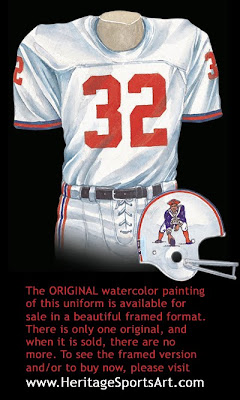
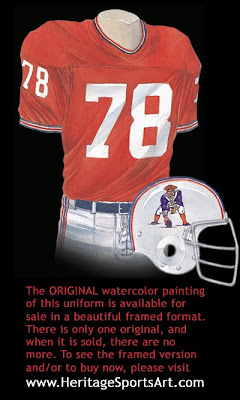






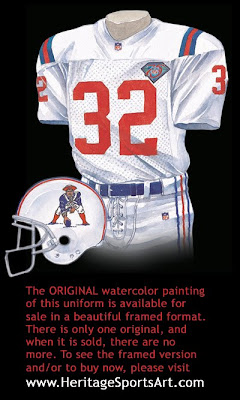
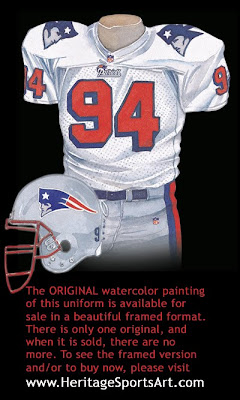
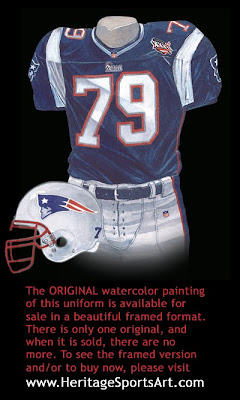


No comments:
Post a Comment
Thank you for taking the time to add a comment - all input is welcome, especially the constructive kind! All the best - Scott